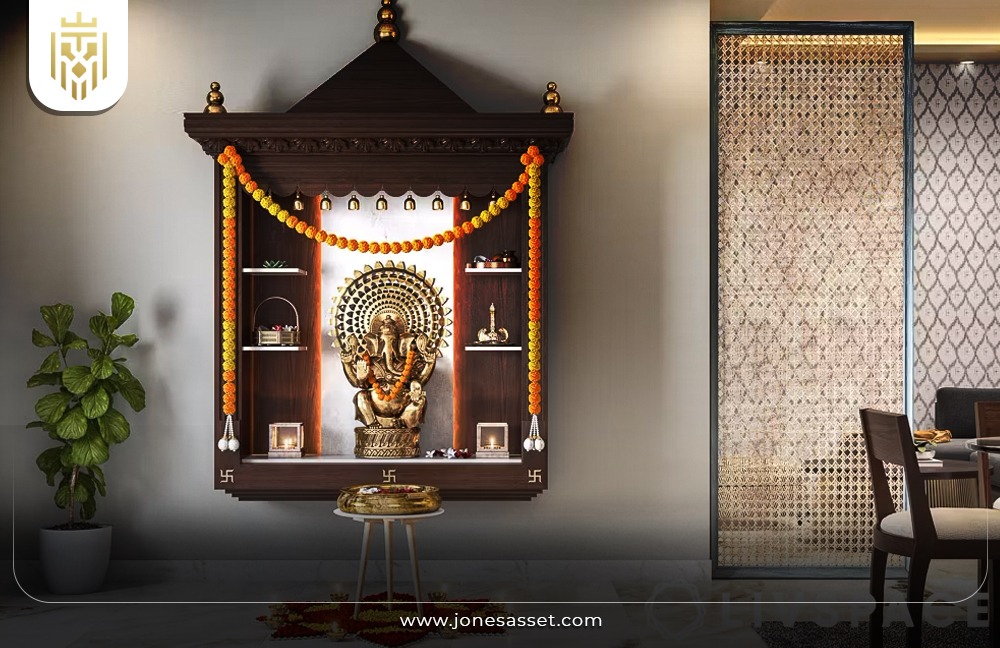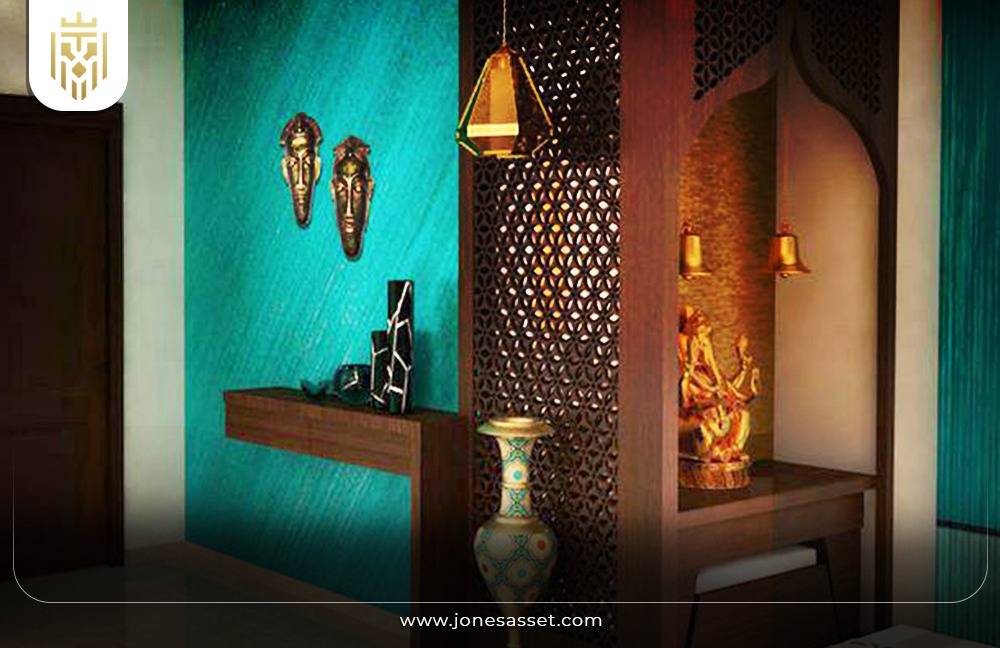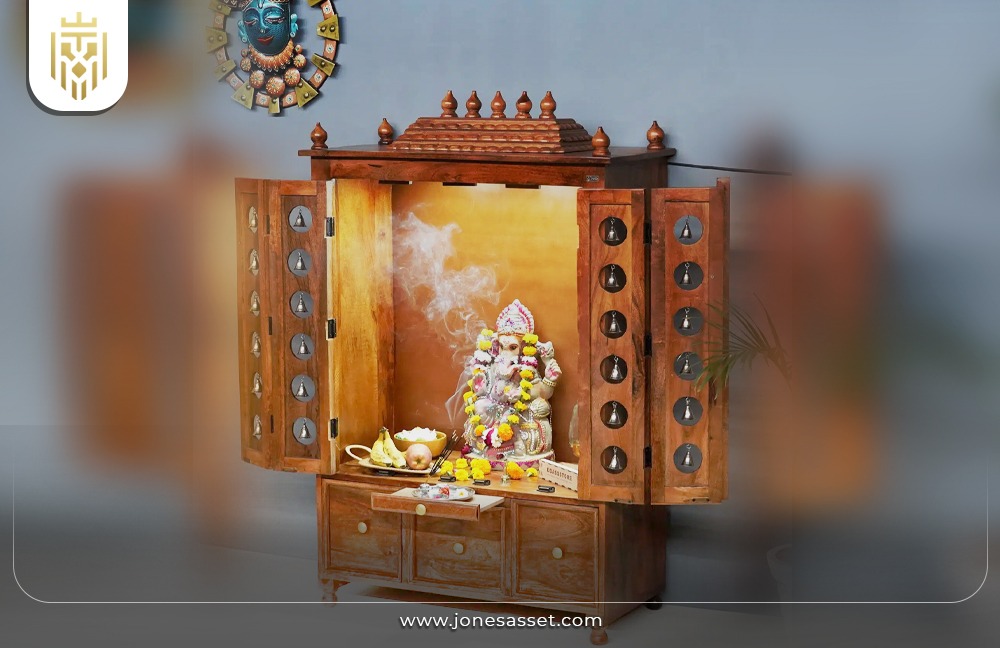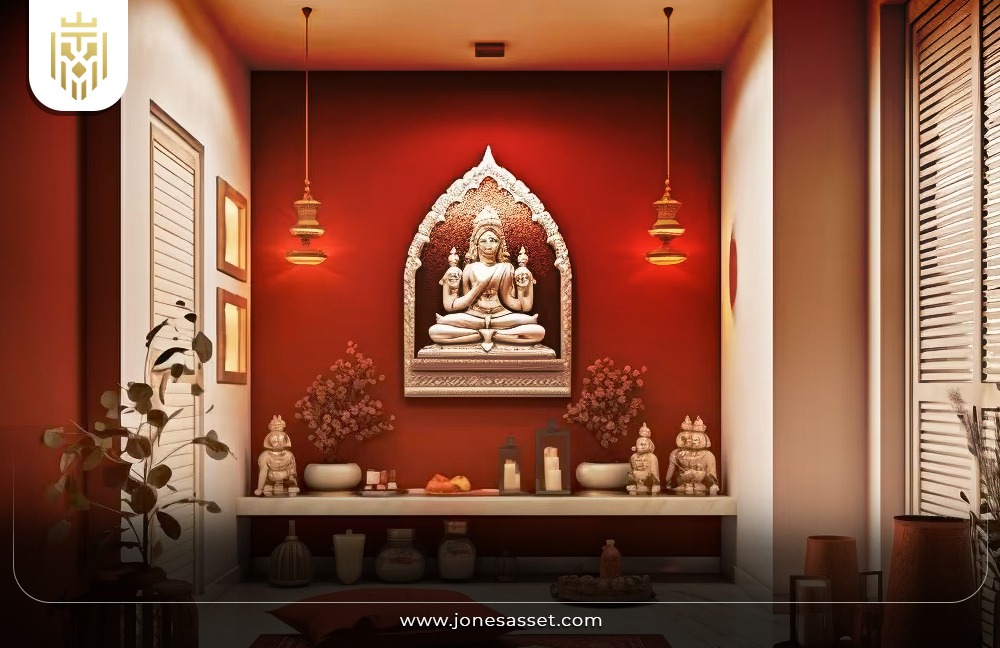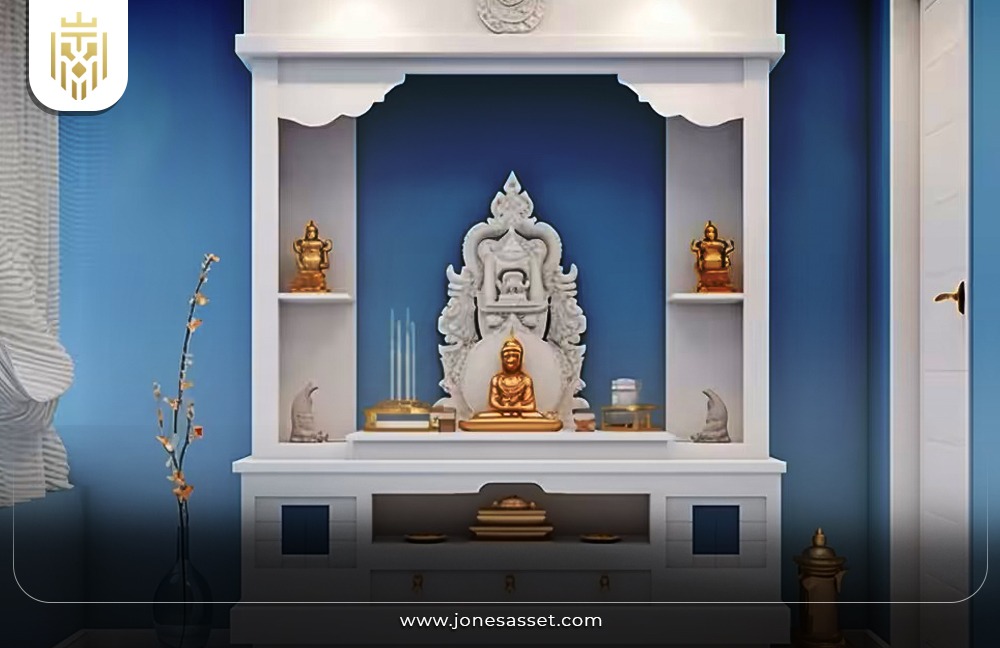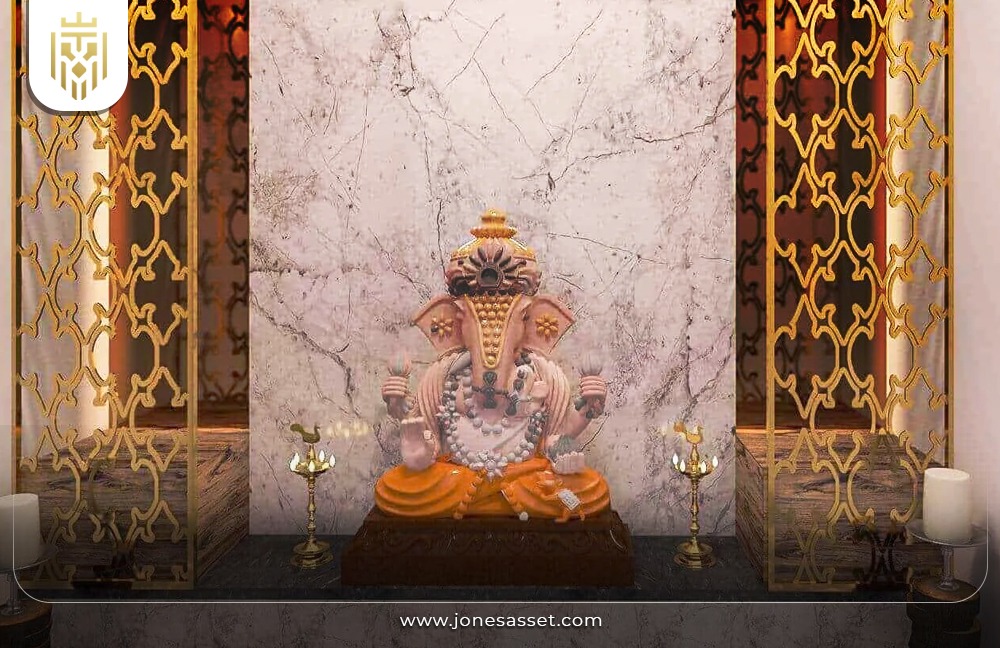Small Pooja Room Designs in Apartments:
Erecting and designing a pooja room in a small apartment is very important to create a good ambiance as well as a well-equipped area for prayers. Strategic spatial management allows even the smallest spaces, like niches, corners, or cabinets, to become meaningful spaces or sacralized. Simplicity in the furniture, including the affordability of multifunctional pieces, is crucial to avoid distractions that disrupt spiritual practices.
Location:
Selecting the site for a pooja room within an apartment is critical in regard to accessibility and positive energy. Ideally, it should be located in a part of the house where it can be less of a disturbance, in a less busy area. In Vastu Shastra, the northeast direction is generally preferred while selecting the plot for construction or any other site. In case space is an issue, then one can use part of the living room or even a closet. Make sure the location is properly lit and aired and should be positioned away from the areas used for bathing or cooking to maintain the holy nature of the place.
Budget:
The best approach to creating a small puja room on a shoestring budget would be smart planning. For the shelves and mantap, the superiors should use cheap material such as wood or medium-density fiberboard. Buy decorations at discounted prices or as second-hand items from outlets such as thrift stores. Emphasis on simplification of decorative items that are simple such as idols, lamps, and small storage shelves.
Size:
In the case of a small pooja room like in an apartment, there should be enough space to place the paraphernalia necessary for worship but the area should look uncongested. Even an altogether small area of 2×2 feet can be converted into an elegant pooja room. Shelves on the wall or a corner piece may serve as a useful way of saving space.
Color Scheme:
When selecting the appropriate color combinations for a small pooja room, the colors chosen should be comfortable and calming and should remind one of a temple. It is beneficial to have light-colored walls such as white, pale beige, and pastel colors as the area appears larger and much more calming. Add some traditional feel to your house by opting for colors such as sandalwood or warm yellow color blends. Exclude very dark and very luminous colors, which can tend to dominate small offices.
Indian Style Pooja Room Designs:
The concepts of Indian-style pooja room designs include the principles of Indian architecture and beliefs and aspirations. It quite often has clinical carving works, stylish mantraps, and symbols like Om or Swastika that are considered propitious. These concepts focus on decor with little to no clutter, adequate use of light, and proper airing out.
Glass Mounted Pooja Room Design:
A pooja room with a glass-mounted look focuses on modernity while retaining the grace associated with such areas for worship. Having glass panels for the enclosure or as doors can give the illusion of space and openness yet, the privacy or seclusion of the area is preserved. Religious motifs can be frosted or etched on the glass which does both provide the amount of privacy desired, as well as the appearance.
Layered Pooja Room Design:
Traditional bespoke pooja rooms have sections with multiple levels that allow the arrangement of idols, lamps, and other artifacts pertaining to the prayer space. This vertical approach grows upward, which makes it ideal for usage in small apartments where space is severely limited. One more advantage is that every layer can be assigned to a certain idol or some ritual items that will look more organized as a whole.
Corner Indian-style Pooja Room:
The corner built-in Indian-style pooja room is ideal for making use of spaces that are left unoccupied most of the time. This design hugs one corner of a room and thus makes great use of space while preserving a special place for prayer. Straight lines, simple geometrical forms, intricate carvings of wooden artifacts, and a small mantap can turn a corner of a room into a spiritual corner. Sufficient lighting such as spotlights or diyas also gives the setting a perfect feel.
Rustic Pooja Room Designs:
There are many ideas in the field of interior design that offer the beauty and simplicity of the countryside, especially for the pooja room. Most of these designs utilize natural elements such as wooden beams, stones, and clay to give the buildings an organic appearance. Carpets and lamps made from terracotta, and raw fiber mats are used to popularize the raw look and feel.
Small Pooja Room with Storage:
Ideally suited for apartments, where space is scarce, a small pooja room with storage is perfect. The incorporation of storage systems such as cabinets, drawers, or shelves ensures that the space remains operational without mess. These storage options will help keep religious books, pooja items, and other essentials in place allowing easy access.
Wall Mounted Pooja Room:
A wall-mounted pooja room is something that can be implemented in a house if the area is small. They are wall-mounted which enables one to create a worship zone without necessarily consuming floor space with the shelves. This design comprises a main shelf to place the idols and other shelves for lamps, incense, and other pooja articles. The wall-mounted pooja rooms can be complemented by backlit panels or by traditional motifs to make them more appealing spiritually.
Movable Small Pooja Room:
Movable small pooja rooms are ideal for the modern apartment as they provide flexibility in addition to ease of setup. They are designs that can be easily moved from one location to the other and they usually have castors on them. A small cabinet or trolley can be used to store idols, lamps, etc., and can be used in order that the pooja room can be shifted as and when required.
Traditional mandir designs that can be placed on the floor:
Floor-oriented traditional mandir designs offer a time-honored and pious aesthetic to the worship area. Such mandirs have artistic looks, and beautiful engravings and are firmly established; the material used in construction varies from wood and marble. Laying the mandir on the ground reflects traditional concepts and provides a stable, calming environment.
Latest Pooja Room Designs:
The modern ideas of the pooja room ideas combine the contemporary styles with some of the classic touches. They include minimalistic design, utilization of natural structures, and incorporation of space-saving storage. Glass-mounted pooja rooms, layered shelves, and bright and bold colors add aesthetic value. Flexible and innovative designs of modular structures and portable pooja units that are acceptable in today’s contexts are designed for modern home spaces.
White Delight in Small Apartment:
A white delight pooja room looks extremely pure and simple. White as the main color for the walls, shelves, and other interior decorations makes the apartment look enormous despite its small size. Decorate with idols of silver or gold and dim lighting to make the ambiance divine. The simplicity and accessibility of this design are suitable for daily prayers because it has a calming atmosphere.
Natural Palette in Small Room:
A natural palette pooja room features a range of colors and elements that are derived from nature to give a calm atmosphere. Natural colors such as beige, brown, and green should be used in the interior, natural wood and stone tones. Add more potted plants and organic material to maintain the calming, earthy ambiance. For instance, this design is best suited for small rooms as it provides a serene environment for prayer and meditation.
Arch Pooja Room Design with Iron Screen:
Another example of the unique Indian style is a pooja room with an arch and an iron screen in the interior. The arch is a good additional piece of architecture, and the iron screen is an elegant divider. This design envisages a separate sanctified area in a room and will enable one to pray without being distracted by other people around. Subtle metallic patterns on the iron screen add to the décor and comprise both classical and modern elements.
Explore creative designs with intricate borders:
Beautifully designed borders to the pooja room add beauty and aesthetic value to the whole sacred area. Incorporate carvings and designs into the moldings or metalworks used around the frame of the area, or the mandap. These borders can be traditional or contemporary designs and also blend the beauty of the motifs. This approach gives the pooja room a very different and more personal look and feel, which makes it one of the most beautiful and sacred spots in the home.
Brighten with Vibrant Backdrop:
Lighting up the place can make a big difference, so it is very suitable to have a colorful environment in the pooja room. Feature bright colors such as red, orange, and yellow behind the idols to enhance their energy and make the environment lucky. Make sure to complement the design with the appropriate furniture and lighting fixtures to bring out the beauty of the space.
Color Combinations that are ideal for Pooja Room:
Hence, one should be very careful while selecting the appropriate color combinations for a pooja room in order to increase the aesthetical and religious value of the room. Muted shades of red and cream, blue and silver, pink and white, or white and gold give the ambiance both tranquil and auspicious feels.
Red and Cream:
Having red and cream as the theme color scheme has a very warm and spiritual feel to it. The color red depicts vigor and enthusiasm, the other color cream gives a touch of serenity. Wearing a combination of red and gold creates a warm and auspicious environment, ideal for a pooja room. Use red in more saturation for the walls or furniture, and cream as a base color so everything is in balance.
Blue and Silver:
Elegant blue and silver spell tranquillity in this pooja room. Blue represents stability and loyalty and silver brings the aspect of elegance and innocence. This combination is good for today’s context and provides a calm worship zone. For the setting, use blue for the walls or furniture and silver for the idols or other decorative items.
Pink and White:
Pink and white colors are very soft and soothing and hence they are well suited for a pooja room. Pink meaning is associated with love and sympathy while white has its connection with purity and peace. This gentle palette is ideal for designing a calm atmosphere generally associated with spirituality. Try to use pink just as a secondary color and utilize white as the main color to keep the mood as light as possible.
White and Gold:
The combination of white and gold always adds a formal and divine look to the interior. Since ancient times, white has been associated with purity and simplicity, and gold with luxury and divinity. This combination results in a bright and positive-looking pooja room. Paint the walls and the major features white, and then use gold on the idols and decor as well as fine details to create a harmonious and otherworldly feeling.
Wrapping Up!
Practical and beautiful tips to make a pooja room stand out from the rest are as follows: From glass-mounted to sophisticated borders, the various techniques present their own advantages for modern innovations as well as the traditional method. Ideal colors add further depth to the ambiance and set a calm and warm tone for worship. Appropriate planning enables even a small pooja room in an apartment house to become the center of spirituality and non-interference.
FAQs
1. How to design a small pooja for apartments?
For a small pooja room, it is recommended to incorporate niches or corners, use wall-mounted shelves, and install foldable mantaps as well. To keep the ambiance organized, incorporate the use of simple furniture and equipment that have multiple functions. They should provide ample lighting and airflow to promote a peaceful atmosphere and the color should also be soft to complement the religious feel of the facility.
2. What are the Indian-style designs for pooja room?
Pooja rooms, as seen in Indian homes, include carved designs, elaborate mandaps, and other motifs. For a realistic look, it is recommended to use wood, brass, or marble for furniture and accessories. Spiritual enhancements such as placing lamps known as diyas, bells, and flowers should be incorporated for a spiritual touch. It is necessary to aim for a clean, quiet, orderly, and culturally enriched environment.
3. What are the Latest Pooja Room Designs?
The current trends in designing a pooja room focus more on simplicity, the use of wooden and natural elements, and built-in cabinets. Some advancements include; the Using of glass-mounted setups, stacked shelves, and bright colors. Flexibility achieved through the use of modular and portable pooja units enables the establishment of appropriate pooja room designs in contemporary living spaces.
4. Best color combinations for pooja rooms?
Preferred color schemes for pooja rooms are red and cream color, blue and silver color, pink and white color, and white and gold color. These pairs provide vigor and serenity, improving the spiritual atmosphere and the looks at the same time. Choose combinations that create harmony and duality of heavenly essence.


